Abstract
Solar photovoltaic (PV) technology has become increasingly common in the energy sector in recent years. India has abundant renewable and non-renewable energy sources. India’s average solar insulation is 5000 T kWh per year (or 500 TW). The main objective of this paper is to present a design for a 581 kWp on-grid solar photovoltaic system at the academic institution using PVsyst software. In our study, works have been carried out to indulge the power losses which occurred due to interconnections, temperature, irradiation, inverter, wiring, soiling, power electronics, and grid availability. The results of our investigation showed the average global horizontal irradiation and PV Plant Performance ratio (PR) were found to be 5.28 kWh/m2/day and 84.14%, respectively. The investigation results of per year production capacity of the proposed plant was found to be 971,271 kWh which is completely CO2-free. As a result, the cost of electricity at the academic institution was Rs 7,915,858/− less per year.
1. Introduction
The rapid depletion of resources from fossil fuel, along with the effect of global warming, has led to an urge to search for an alternative energy sources. Recent research indicates that renewable energy has enormous potential and can be used to meet the world’s energy demands [1,2]. India is well-supplied with renewable energy resources, and its enormous potential must be used to increase the accessibility, affordability, and dependability of the country’s power supply. The most common method of generating power from solar energy is through usage of PV technology or a PV system [3]. The boom of the solar PV industry was fueled by the negative consequences of using traditional resources and the growing demand for energy. Solar companies are booming quickly in India and around the world, thanks to the government’s support and lower costs. The global demand for energy for various developmental activities has risen in almost every region. As fossil fuel based energy becomes increasingly scarce, it is time to turn to renewable energy sources, including hydropower, wind, solar, and biomass plants to generate energy to solve the problem [4,5,6,7]. In order to maintain a balanced state of power generation and to overcome the depletion of fossil fuel resources, several power plantations, including solar, wind, hydroelectric, biomass, geothermal and many more, have been established in various places.
Power generation from solar energy is one of the most convenient methods for easy installation, accessibility, low cost, and energy transmission and conservation. Many solar panels are installed on the rooftop of the building for power generation. This paper aims to focus on modeling of a 581 kWp solar power plant installed on an academic building. The solar power plant consists of operating blocks as shown in Figure 1.
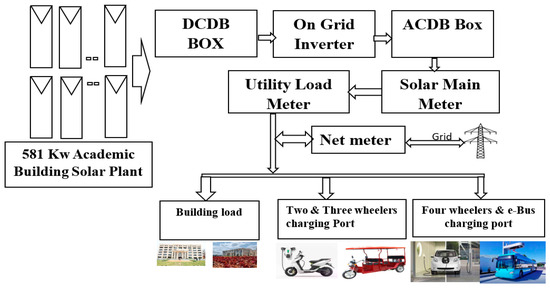
Figure 1.
A 581 kWp Academic Building Solar Power Plant Schematic Diagram.
The power plant consists of an arrangement of solar panels connected in series and parallel, constituting the solar array for the proposed 581 kWp plant. The array is connected to a grid tied inverter via Direct Current Distribution Box (DCDB). The DCDB box uses protective measurements such as a Miniature Circuit Breaker (MCB) and surge protection devices. The inverter converts DC solar array input into compatible grid-equivalent AC output and the same output will be synchronized with the grid. Inverters contain anti-islanding protection measures and the further output of inverter is connected to an Alternative Current Distribution Box (ACDB), which has an inbuilt MCB and surge protection devices for safety purposes. The output of ACDB is connected to the solar main meter where we monitor the solar generation data and the same meter is connected to the utility panel. Solar net metering devices are used for energy export and import purposes. The actual plant photos, a single-line diagram of the plant, the interconnected configuration of the solar array and inverters, and other components are shown in Figure 2.
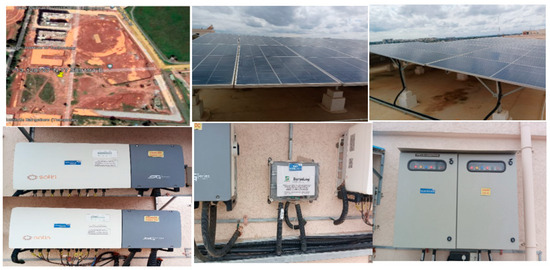
Figure 2.
581 Kw solar actual power plant diagram.
Several countries have developed solar photovoltaic projects to generate electricity, far exceeding the global average. India has a huge potential for solar-radiated electricity production. The favorable geographical location benefits the plant with a significant amount of solar irradiance almost all year. Approximately 4.7 kWh/m2/day of solar irradiance is received in most areas of India, and the country’s land mass is forecast to receive approximately 5000 trillion kWh of solar energy per year [8,9,10,11,12]. Due to rapidly reducing cost of PV modules, in the future PV systems will become one of the main sources of electricity around the world [13,14,15]. The simulation system is mainly used to analyze and measure the performance of a grid-connected PV generation network. In this study measurement and analysis of the grid-connected PV system and the system’s performance was carried out by PVSyst software, Version 7.3.4 [16,17,18,19,20].
2. Methodology
The performance of a grid-connected PV system with a capacity of 581 kWp was investigated using the PVSyst simulation platform. PVSyst software is utilized to account for all the power losses. A total of 1,056,550 − Watt Trina solar photovoltaic modules and six 80 KW, 3Φ, 400 V Delta inverters were used to construct a 581 kWp grid-connected solar photovoltaic system. The technical datasheet of solar photovoltaic modules and inverters are shown in Table 1 and Table 2, respectively.

Table 1.
Technical datasheet of a 550 − Watt Trina solar panel.

Table 2.
Technical datasheet of inverter.
A technical datasheet of 550-Watt Trina solar panel, along with the output of a solar panel at standard test conditions, is shown in Figure 3.
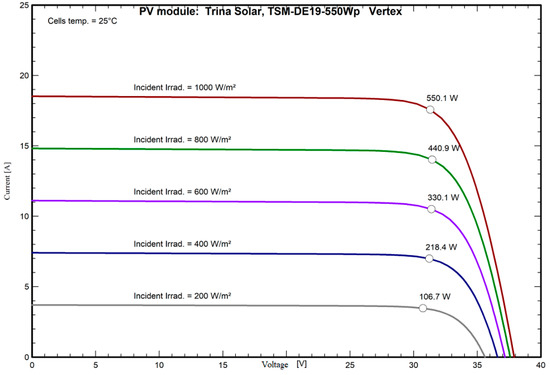
Figure 3.
V-I Characteristics of PV panel.
The technical datasheet of Delta Energy made on a Grid inverter is shown in Figure 4.
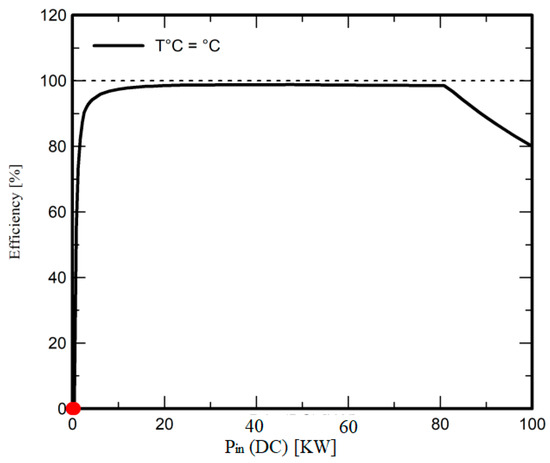
Figure 4.
Technical datasheet of Delta Energy makes on Grid inverter efficiency curve of a 100 KW Inverter.
The solar PV array configurations are shown in Figure 5. All modules are mounted at an azimuth angle of 0° with an inclination angle of 15° facing south and are free of any shading impact.

Figure 5.
Solar PV array configurations.
The above Figure indicates that a total of 1022 solar panels used here form 48 strings of 22 series modules. Six inverters of 80 kWp having 12 MPPT units are present and their output is injected into the grid.
3. Results Analysis
According to the PVSyst simulation, maximum energy generation occurs in February and minimum energy generation occurs in July. Figure 6 below summarizes the overall performance evaluation and performance ratio of the MIT 581 KW Solar PV Plant.
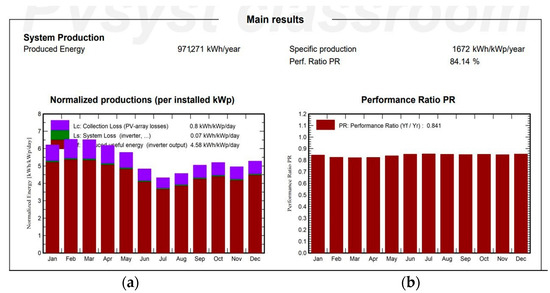
Figure 6.
MIT 581 KW Solar PV Plant Analysis (a) Performance evaluation and (b) Performance ratio of the MIT 581 KW Solar PV Plant. Legends: E Array—Effective energy at the output of the array. E Grid—Energy injected into grid.
Figure 7 shows a power loss diagram for a 581 kW MIT Solar PV Plant due to wiring, soiling, power electronics, inverter, irradiation, temperature, interconnections, and grid availability.
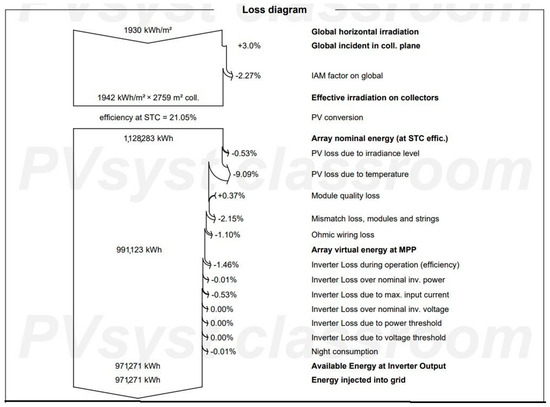
Figure 7.
Loss diagram over the year.
The most energy is pumped into the grid in February, while July sees the least amount. A total of 1930 kWh/m2 was found to be the global average of horizontal radiation. The total incident energy on the collector plane was obtained to be 1987 kWh/m2. The PV system’s performance ratio was measured to be 84.14%.
4. Conclusions
The output performance of a roof-mounted solar PV system of 581 kWp grid based on monthly and annual parameters was evaluated. The data simulation was carried out using the PVSyst software tools. The most important results from the current research are summarized below.
The most energy was given to the grid in March, whereas August held the least. The solar PV system of 581 kWp is performing well, with a PR of 84.14%. During the investigation, it was discovered that in the financial year 2022, 971,271 kWh of CO2-free solar energy was obtained at the output of the Solar PV array. This saved the MIT academic campus Rs 7,915,858 per year on its electricity bill. Over 25 years, approximately Rs. 197,896,466/− of electricity bill could be saved.
Author Contributions
J.R.H., M.B., P.K. and N.G. contributed equally. All authors have read and agreed to the published version of the manuscript.
Funding
This research received no external funding.
Institutional Review Board Statement
Not applicable.
Informed Consent Statement
Not applicable.
Data Availability Statement
Data are contained within the article.
Acknowledgments
The authors would also like to express their sincere gratitude to Manipal Institute of Technology Bengaluru for providing the technical support.
Conflicts of Interest
The authors declare no conflicts of interest.
References
- Kumar, B.S.; Sudhakar, K. Performance evaluation of 10 MW grid connected solar photovoltaic power plant in India. Energy Rep. 2015, 1, 184–192. [Google Scholar] [CrossRef]
- Alsadi, S.; Khatib, T. Photovoltaic Power Systems Optimization Research Status: A Review of Criteria, Constrains, Models, Techniques, and Software Tools. Appl. Sci. 2018, 8, 1761. [Google Scholar] [CrossRef]
- Sharma, S.; Kurian, C.P.; Paragond, L.S. Solar PV System Design Using PVsyst: A Case Study of an Academic Institute. In Proceedings of the 2018 International Conference on Control, Power, Communication and Computing Technologies (ICCPCCT), Kannur, India, 23–24 March 2018; pp. 123–128. [Google Scholar] [CrossRef]
- Sheoran, M.; Kumar, P.; Sharma, S.; Bukya, M. Current situation analysis of solar PV waste management in India. Mater. Today: Proc. 2022, 58, 773–782. [Google Scholar] [CrossRef]
- Adaramola, M.S. Viability of grid-connected solar PV energy system in Jos, Nigeria. Int. J. Electr. Power Energy Syst. 2014, 61, 64–69. [Google Scholar] [CrossRef]
- Anonymous 2017 Press Information Breau, Ministry of New and Renewable Energy, Government of India. Available online: http://pib.nic.in/newsite/pmreleases.aspx?mincode=28 (accessed on 13 August 2017).
- Kumar, P.; Bukya, M.; Shankar, A.; Garg, P.; Gowtham, N. An experimental approach towards cost benefit analysis of 850 kW solar PV plant. Vis. Sustain. 2023, 19, 255–266. [Google Scholar] [CrossRef]
- Ayompe, L.M.; Dufy, A.; McCormack, S.J.; Conlon, M. Measured performance of a 1.72 kW rooftop grid connected photovoltaic system in Ireland. Energy Convers. Manag. 2011, 52, 816–825. [Google Scholar] [CrossRef]
- Baltus CW, A.; Eikelboom, J.A.; Van Zolingen, R.J.C. Analytical monitoring of losses in PV systems. In Proceedings of the 14th European Photovoltaic Solar Energy Conference, Barcelona, Spain, 30 June–4 July 1997. [Google Scholar]
- Garg, P.; Bukya, M.; Kumar, P. Cost Benefit Analysis of 50 kW Solar Power Plant for Educational Hostel Building. In Proceedings of the 2022 2nd International Conference on Innovative Sustainable Computational Technologies (CISCT), Dehradun, India, 23–24 December 2022; pp. 1–5. [Google Scholar] [CrossRef]
- Chaita, A.; Kluabwang, J. Performance evaluation of 3.5 kWp rooftop solar PV plant in Thailand. In Proceedings of the International MultiConference of Engineers and Computer Scientists, Vol II, IMECS 2016, Hong Kong, China, 16–18 March 2016. [Google Scholar]
- Tamoor, M.; Bhatti, A.R.; Farhan, M.; Miran, S.; Raza, F.; Zaka, M.A. Designing of a Hybrid Photovoltaic Structure for an Energy-Efficient Street Lightning System Using PVsyst Software. Eng. Proc. 2021, 12, 45. [Google Scholar] [CrossRef]
- Nfaoui, M.; El-Hami, K. Extracting the maximum energy from solar panels. Energy Rep. 2018, 4, 536–545. [Google Scholar] [CrossRef]
- Gao, Z.; Li, S.; Zhou, X.; Ma, Y. An overview of PV system. In Proceedings of the 2016 IEEE International Conference on Mechatronics and Automation, Harbin, China, 7–10 August 2016; pp. 587–592. [Google Scholar]
- Irwanto, M.; Safwati, I.; Gomesh, N. Analysis simulation of the photovoltaic output performance. In Proceedings of the 2014 IEEE 8th International Power Engineering and Optimization Conference (PEOCO2014), Langkawi, Malaysia, 24–25 March 2014; pp. 477–481. [Google Scholar]
- Sheoran, M.; Kumar, P.; Sharma, S.; Bukya, M. After Life Cost Modelling of 160 kW Grid Integrated Solar Photovoltaic Plant: BSDU Jaipur. In Flexible Electronics for Electric Vehicles; Dwivedi, S., Singh, S., Tiwari, M., Shrivastava, A., Eds.; Lecture Notes in Electrical Engineering; Springer: Singapore, 2023; Volumr 863. [Google Scholar] [CrossRef]
- Bukya, M.; Kumar, P.; Kumar, R. On-Grid Solar Photovoltaic Power Plant Analysis Under PVsyst Simulation Software Platform. In Flexible Electronics for Electric Vehicles; Dwivedi, S., Singh, S., Tiwari, M., Shrivastava, A., Eds.; Lecture Notes in Electrical Engineering; Springer: Singapore, 2023; Volume 863. [Google Scholar] [CrossRef]
- Siregar, Y.; Hutahuruk, Y.; Suherman. Optimization Design and Simulating Solar PV System Using PVSyst Software. In Proceedings of the 2020 4th International Conference on Electrical, Telecommunication and Computer Engineering (ELTICOM), Medan, Indonesia, 3–4 September 2020; pp. 219–223. [Google Scholar] [CrossRef]
- Sharma, S.; Bukya, M.; Kumar, P. PVsyst modeling of 800 kWp capacity grid-tied solar photovoltaic power plant for academic institution. Vis. Sustain. 2023, 20, 175–188. [Google Scholar] [CrossRef]
- Dalal, S.; Jadhav, V.; Raut, R.; Narkhede, S. Analysis of 1KW Solar Rooftop System by Using PYSyst. In Proceedings of the 2nd International Conference on Communication & Information Processing (ICCIP), Pune, India, 26–27 June 2020. [Google Scholar]
Disclaimer/Publisher’s Note: The statements, opinions and data contained in all publications are solely those of the individual author(s) and contributor(s) and not of MDPI and/or the editor(s). MDPI and/or the editor(s) disclaim responsibility for any injury to people or property resulting from any ideas, methods, instructions or products referred to in the content. |
© 2024 by the authors. Licensee MDPI, Basel, Switzerland. This article is an open access article distributed under the terms and conditions of the Creative Commons Attribution (CC BY) license (https://creativecommons.org/licenses/by/4.0/).